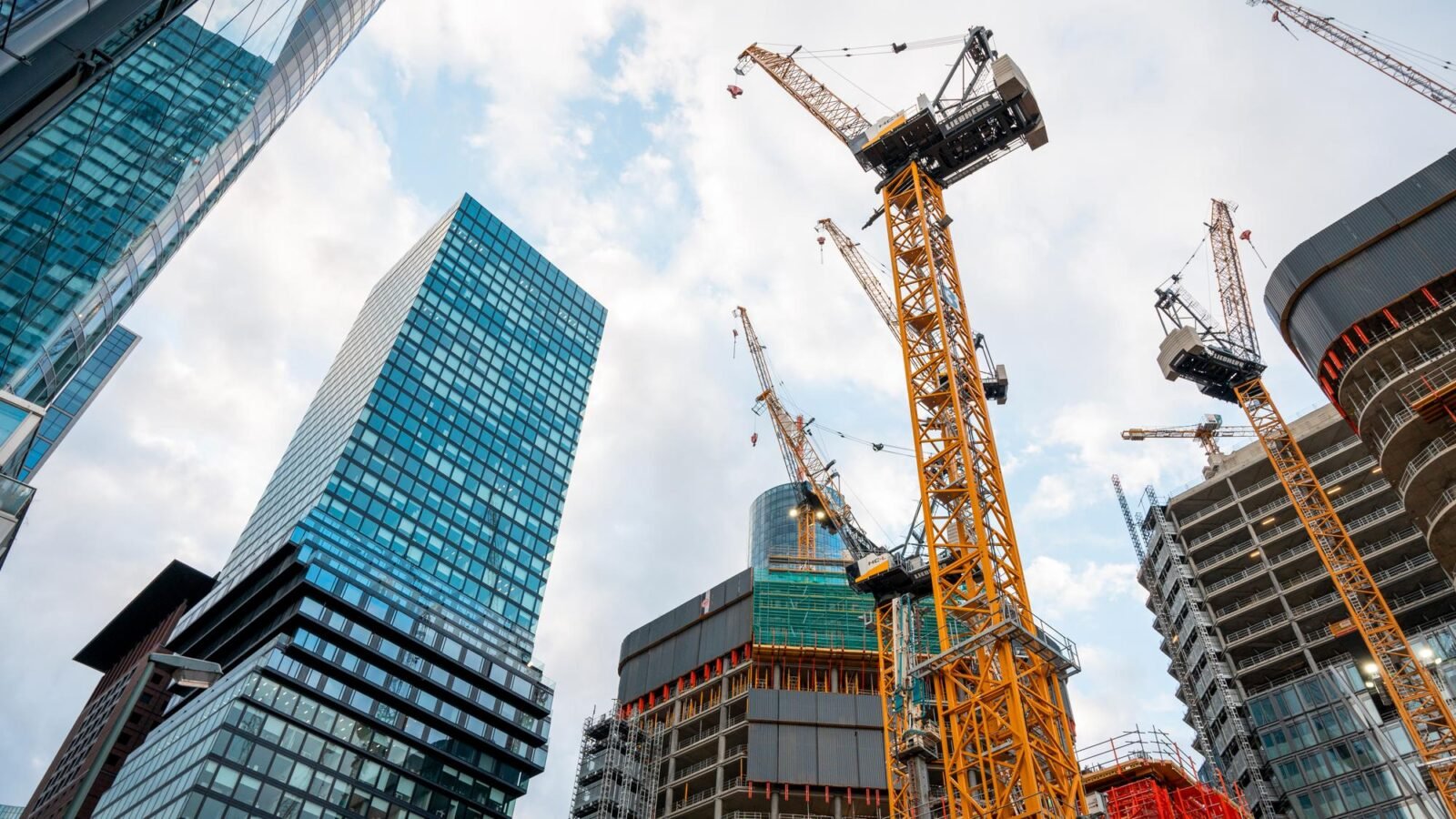
Introduction: Navigating the Future of Construction
Table of Contents
Nowadays is essential to future-proof your construction business. The construction industry is undergoing a significant transformation. Emerging technologies, changing consumer preferences, and environmental concerns are reshaping the landscape. Today’s construction businesses are not just about bricks and mortar; they are about innovation and sustainability.
As we move forward, the importance of adapting to new trends cannot be overstated. Companies that embrace change are more likely to thrive in a competitive market. With the rise of green building practices, for instance, there is a growing demand for sustainable construction methods. Clients are increasingly looking for energy-efficient designs that minimize environmental impact.
But it’s not just sustainability driving change. Advancements in AI and automation are optimizing construction processes, making them more efficient and cost-effective. Adapting to these technologies can provide a competitive edge. Additionally, as new building materials and techniques emerge, staying informed allows businesses to leverage innovations that can enhance project quality.
Legal requirements and building codes are also evolving. Compliance with these regulations is essential for maintaining business stability. Companies that fail to keep pace with these changes risk losing out on lucrative opportunities.
In this rapidly changing environment, the key to long-term success lies in flexibility and adaptability. By recognizing the trends and adjusting accordingly, construction businesses can not only survive but thrive. The future is bright for those willing to innovate and embrace the new realities of the industry.
Embracing Green Building Practices
The construction industry is experiencing a remarkable shift towards sustainability. With an increasing awareness of environmental issues, the demand for sustainable construction is at an all-time high. Homebuyers and businesses alike are seeking buildings that not only look good but also contribute positively to the planet.
Recent statistics show that green building practices are gaining traction. In fact, according to the U.S. Green Building Council, more than 40% of commercial buildings are now constructed with sustainable practices in mind. This number is expected to grow as awareness and regulations evolve.
Embracing energy-efficient designs offers numerous benefits for construction businesses:
Cost Savings: Energy-efficient buildings often reduce operating costs, leading to long-term savings for owners.
Market Appeal: Properties with green certifications can attract more buyers and tenants, boosting occupancy rates.
Regulatory Incentives: Many governments offer tax incentives and grants for sustainable construction, helping to offset initial investments.
Enhanced Comfort: Energy-efficient designs improve indoor air quality and comfort, making spaces more enjoyable for occupants.
As the industry continues to evolve, adopting green building practices not only positions your business as a leader but also aligns with the growing preferences of today’s consumers. By investing in sustainability, you are not just meeting demand; you are paving the way for a more resilient and responsible construction future.
AI and Automation Revolution
The construction industry is on the brink of a technological transformation, largely driven by AI and automation. These advancements are not just about keeping pace with competition; they are essential for optimizing construction processes and enhancing efficiency.
AI plays a crucial role in streamlining various aspects of construction. From project planning to risk management, AI can analyze vast amounts of data to predict project outcomes, identify potential issues, and suggest optimal solutions. This predictive capability can significantly reduce delays and cost overruns.
Several automation tools are making waves in the industry:
Building Information Modeling (BIM): This tool allows for detailed 3D modeling that helps in visualizing projects before construction begins, minimizing errors and rework.
Drones: Used for site surveys, drones provide real-time data on project progress and site conditions, improving decision-making.
Robotics: Automated machinery, such as bricklaying robots, can perform repetitive tasks faster and more accurately than human labor.
Here’s a quick comparison of traditional versus automated processes:
Aspect | Traditional Processes | Automated Processes |
|---|---|---|
Planning | Manual data analysis | AI-driven insights |
Site Surveys | On-foot inspections | Drones for aerial surveys |
Labor | Human labor for repetitive tasks | Robotics for efficiency |
“AI is revolutionizing the construction industry, making processes faster, more efficient, and less prone to error.” This transformation is not just a trend; it’s becoming the standard. As businesses adopt these technologies, the potential for improved productivity and reduced costs will be significant.
In conclusion, integrating AI and automation into your construction business is not just about staying relevant. It’s about laying the foundation for a more efficient, innovative future.
Innovative Building Materials
The construction industry is evolving, and so are the materials we use. Innovative building materials are at the forefront of this change, enhancing durability, sustainability, and overall efficiency. One standout example is self-healing concrete. This remarkable material can repair its own cracks, extending the lifespan of structures and reducing maintenance costs.
Self-healing concrete contains special additives that react with water and carbon dioxide. When cracks form, these additives activate and fill the gaps, effectively healing the concrete. This innovation addresses one of the most common issues in construction: wear and tear over time.
Beyond self-healing concrete, here are some other innovative materials gaining traction in the industry:
Geopolymer concrete: Made from industrial waste, it has a lower carbon footprint compared to traditional concrete.
Recycled steel: Utilizes scrap metal, reducing energy consumption and waste.
Cross-laminated timber (CLT): A sustainable alternative to concrete, offering excellent strength-to-weight ratios.
Smart glass: Adjusts to light conditions, improving energy efficiency in buildings.
So, why should builders consider these materials? The advantages over traditional options are clear. For example, self-healing concrete not only reduces repair costs but also enhances durability. Studies show that it can last up to 25% longer than conventional concrete.
In summary, embracing innovative building materials can set your construction business apart. By investing in these advancements, you’re not only ensuring a more sustainable future but also increasing the longevity of your projects. In a rapidly changing market, this approach is essential for staying competitive.

Adapting to Legal Changes
The construction industry is not just about bricks and mortar; it also involves navigating a complex landscape of laws and regulations. Recent changes in building codes have significantly impacted how construction businesses operate. Staying informed and compliant is crucial for long-term stability.
Recent Changes in Building Codes
In recent years, many jurisdictions have updated their building codes to enhance safety, sustainability, and energy efficiency. These changes often reflect advancements in technology and shifts in societal expectations. For example, new codes may mandate the use of sustainable materials or stricter safety measures. Ignoring these updates can lead to costly fines and project delays.
Importance of Compliance
Compliance isn’t just a legal obligation; it’s a cornerstone of business stability. A legal expert notes, “Failure to comply with building codes can jeopardize a company’s reputation and bottom line. Regularly reviewing and adapting to legal changes is essential for any construction business aiming for longevity.” This means staying engaged with local regulations and understanding how they affect your projects.
Moreover, compliance can open doors to new opportunities. Many clients prefer contractors who prioritize legal adherence, as it reflects a commitment to quality and safety. By ensuring that your business aligns with current standards, you position yourself as a trusted partner in the industry.
In conclusion, adapting to legal changes is not merely reactive; it’s a proactive strategy that can safeguard your construction business. By staying informed and compliant, you can mitigate risks and enhance your competitive edge in this ever-evolving market.
Staying Agile in a Competitive Market
In today’s fast-paced construction industry, agility is crucial for success, it becomes one of the many factors to future-proof your construction business. As market demands shift, businesses must adopt strategies that allow them to pivot quickly and efficiently.
One effective strategy for maintaining flexibility is to foster a culture of continuous improvement. Encourage your team to embrace change and innovate. Regular training sessions can prepare your workforce to adapt to new technologies and methods. This proactive approach not only enhances skill sets but also boosts morale.
Another key strategy is to collaborate with suppliers and subcontractors. Building strong relationships can lead to better communication and quicker decision-making. For instance, having a reliable network allows you to source materials promptly, avoiding delays that can impact project timelines.
A notable case study is the success of XYZ Construction, which implemented agile project management techniques. By breaking projects into smaller, manageable phases, they could quickly adjust to client feedback and market changes. This approach not only improved client satisfaction but also reduced costs by minimizing waste.
As one industry leader said, “Agility is not just about speed; it’s about responding effectively to change.” This mindset can be the difference between thriving and merely surviving in a competitive market.
In summary, staying agile involves continuous learning, strong partnerships, and an adaptive approach to project management. By implementing these strategies, construction businesses can navigate uncertainties and position themselves for long-term success.
FAQ: Common Concerns in Future-Proofing
As the construction industry evolves, many business owners have questions about how to adapt effectively. Here are some common concerns and straightforward answers to guide you.
Q: What are the most important trends to watch in construction?
A: Key trends include green building practices, AI and automation, innovative materials, and changing legal requirements. Staying informed about these trends can help you stay competitive.
Q: How can I implement sustainable practices without increasing costs?
A: Investing in energy-efficient designs can lead to long-term savings. Additionally, many green technologies are now more affordable. Start small and gradually integrate more sustainable practices into your projects.
Q: What role does technology play in future-proofing my business?
A: Technology, particularly AI and automation, can streamline processes, reduce errors, and improve efficiency. Embracing these tools can help you stay ahead in a changing market.
Q: How can I ensure compliance with new legal requirements?
A: Regular training for your team and staying updated on local regulations are essential. Consider consulting with legal experts to ensure your projects meet all requirements.
Q: Is it necessary to change my business model?
A: Depending on market shifts, it might be necessary. Assess your current model and adapt as needed to align with industry trends. Flexibility is key to long-term success.
By addressing these common concerns, you can better prepare your construction business for the future. Stay proactive, and embrace change to thrive in an evolving landscape.

Conclusion: Building a Resilient Future
As you future-proof your business in the rapidly changing landscape of the construction industry it becomes not just an option; but a necessity. Throughout this article, we’ve explored crucial strategies that can help you navigate these shifts effectively. Embracing green building practices is essential, as sustainability becomes a significant demand from clients. Incorporating AI and automation will enhance efficiency and reduce costs, making your operations smoother and more competitive.
Additionally, adopting innovative building materials can set you apart from your competitors. Staying compliant with changing legal requirements is vital for maintaining stability in your projects. Finally, remember that agility is your ally in a competitive market; being able to pivot quickly can lead to new opportunities.
These strategies are not just about keeping pace with change; they’re about setting the pace. The construction industry is evolving, and those who stay informed and proactive will thrive. Make it a priority to continuously educate yourself and your team about emerging trends and technologies. Attend industry seminars, engage with online resources, and network with other professionals to gain insights.
The future is bright for those willing to adapt. By implementing these strategies and fostering a culture of innovation within your business, you can build a resilient future. Remember, the key to success lies in your ability to embrace change and leverage it to your advantage. Your proactive approach today will secure a prosperous tomorrow for your construction business.
Data Highlights
As we navigate the evolving landscape of the construction industry, it’s crucial to stay informed about key statistics and growth trends. These data points not only illustrate the current state of the market but also provide insights into future opportunities. Below is a table summarizing important data highlights:
Statistic | Value | Explanation |
|---|---|---|
Global Green Building Market Growth | $1.5 trillion by 2025 | This growth reflects the increasing demand for sustainable construction practices, driven by both regulatory requirements and consumer preferences. |
AI Adoption in Construction | 45% of construction firms by 2025 | With the rise of AI technologies, a significant portion of firms is expected to adopt AI solutions to enhance efficiency and reduce costs. |
Self-Healing Concrete Market Value | $1.5 billion by 2028 | This innovative material is gaining traction due to its long-term durability and cost-saving benefits, marking a shift in construction material preferences. |
Compliance with New Building Codes | 80% of projects face regulatory challenges | As building codes evolve, many firms struggle to stay compliant, highlighting the need for continual education and adaptation. |
These statistics emphasize the importance of adapting to new trends and technologies. The growth in the green building market indicates that sustainability is becoming essential for client satisfaction. Similarly, the predicted uptick in AI adoption showcases how technology can streamline operations.
Finally, understanding the market for innovative materials like self-healing concrete can provide a competitive edge. Staying ahead of regulatory changes is just as critical, as non-compliance can lead to costly setbacks. By keeping these data points in mind, construction businesses can better position themselves for a resilient future.
Join HandyRate and network and grow with us. Connect with us on
Facebook, Instagram and Twitter . We hope to see you soon!



